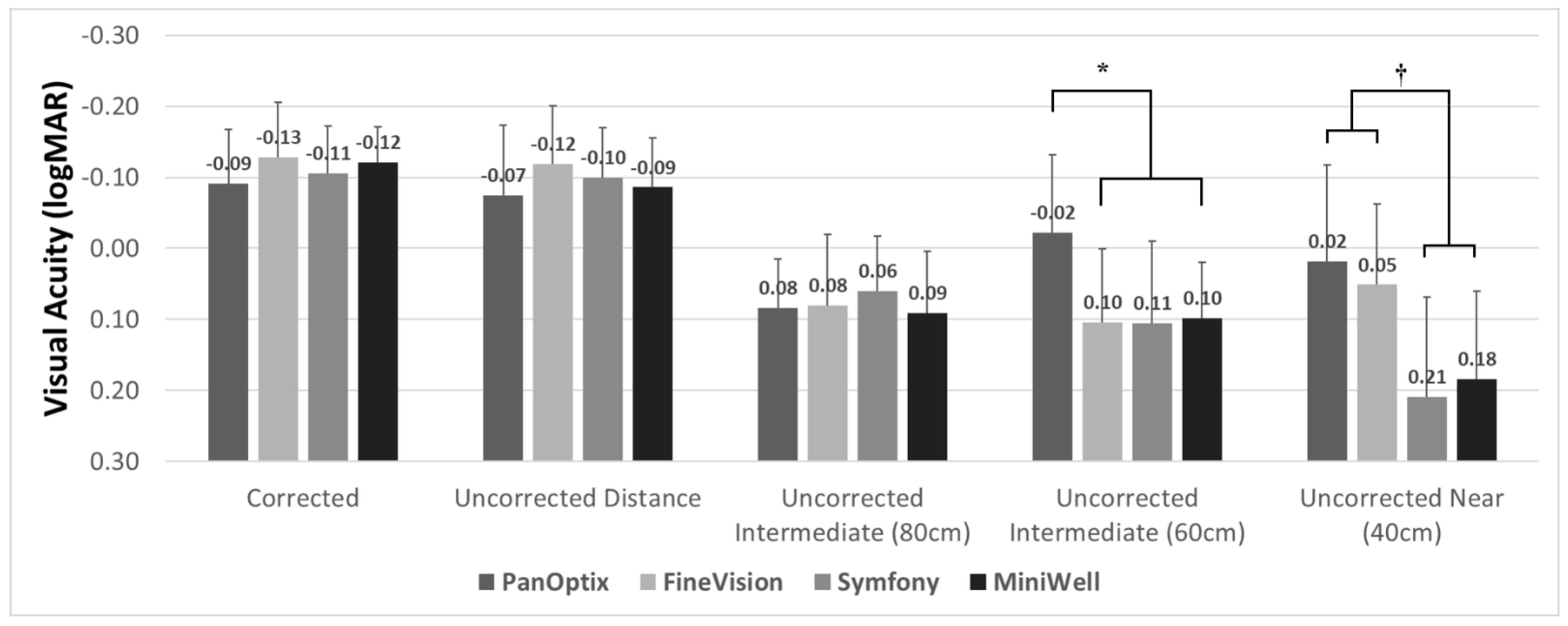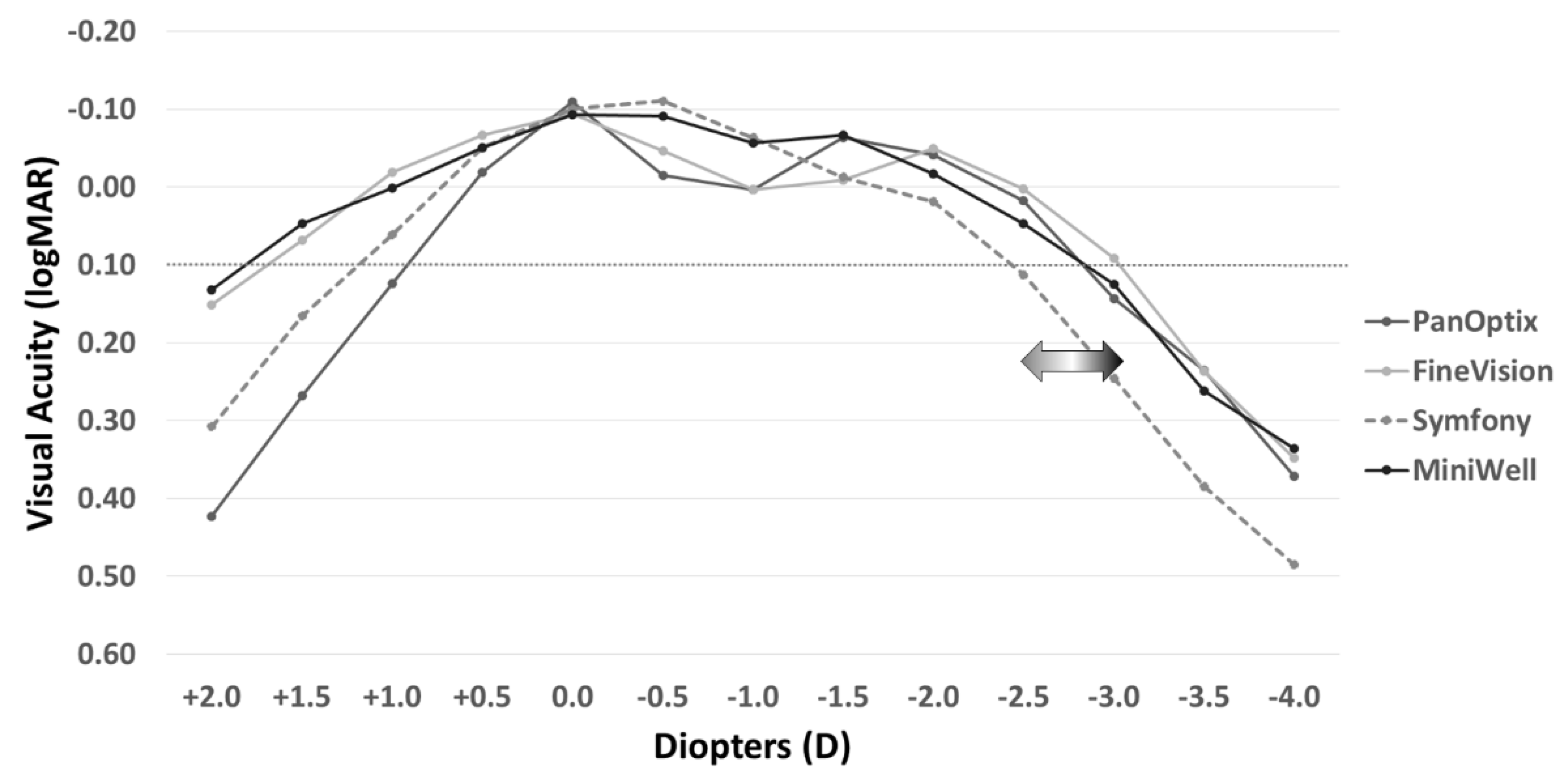Clinical Outcomes after Bilateral Implantation of Trifocal Diffractive Intraocular Lenses and Extended Depth of Focus Intraocular Lenses
Abstract
1. Introduction
2. Methods
2.1. Study Design
2.2. Intraocular Lenses
2.3. Preoperative Assessment, Surgery, and Postoperative Evaluation
2.4. Statistical Analysis
3. Results
Baseline Characteristics
4. Discussion
Supplementary Materials
Author Contributions
Funding
Institutional Review Board Statement
Informed Consent Statement
Data Availability Statement
Conflicts of Interest
References
- Agresta, B.; Knorz, M.C.; Kohnen, T.; Donatti, C.; Jackson, D. Distance and near visual acuity improvement after implantation of multifocal intraocular lenses in cataract patients with presbyopia: A systematic review. J. Refract. Surg. 2012, 28, 426–435. [Google Scholar] [CrossRef] [PubMed]
- Mesci, C.; Erbil, H.; Ozdoker, L.; Karakurt, Y.; Bilge, A.D. Visual acuity and contrast sensitivity function after accommodative and multifocal intraocular lens implantation. Eur. J. Ophthalmol. 2010, 20, 90–100. [Google Scholar]
- Calladine, D.; Evans, J.R.; Shah, S.; Leyland, M. Multifocal versus monofocal intraocular lenses after cataract extraction. Cochrane Database Syst. Rev. 2012, CD003169. [Google Scholar] [CrossRef]
- Cochener, B.; Lafuma, A.; Khoshnood, B.; Courouve, L.; Berdeaux, G. Comparison of outcomes with multifocal intraocular lenses: A meta-analysis. Clin. Ophthalmol. 2011, 5, 45–56. [Google Scholar] [CrossRef] [PubMed][Green Version]
- Hutz, W.W.; Eckhardt, H.B.; Rohrig, B.; Grolmus, R. Intermediate vision and reading speed with array, Tecnis, and ReSTOR intraocular lenses. J. Refract. Surg. 2008, 24, 251–256. [Google Scholar] [CrossRef]
- Jonker, S.M.; Bauer, N.J.; Makhotkina, N.Y.; Berendschot, T.T.; van den Biggelaar, F.J.; Nuijts, R.M. Comparison of a trifocal intraocular lens with a +3.0 D bifocal IOL: Results of a prospective randomized clinical trial. J. Cataract Refract. Surg. 2015, 41, 1631–1640. [Google Scholar] [CrossRef]
- Cochener, B. Prospective Clinical Comparison of Patient Outcomes Following Implantation of Trifocal or Bifocal Intraocular Lenses. J. Refract. Surg. 2016, 32, 146–151. [Google Scholar] [CrossRef]
- Pedrotti, E.; Bruni, E.; Bonacci, E.; Badalamenti, R.; Mastropasqua, R.; Marchini, G. Comparative Analysis of the Clinical Outcomes With a Monofocal and an Extended Range of Vision Intraocular Lens. J. Refract. Surg. 2016, 32, 436–442. [Google Scholar] [CrossRef]
- Sudhir, R.R.; Dey, A.; Bhattacharrya, S.; Bahulayan, A. AcrySof IQ PanOptix Intraocular Lens Versus Extended Depth of Focus Intraocular Lens and Trifocal Intraocular Lens: A Clinical Overview. Asia Pac. J. Ophthalmol. 2019, 8, 335–349. [Google Scholar] [CrossRef]
- Hwang, S.; Lim, D.H.; Hyun, J.; Kim, M.J.; Chung, T.Y. Myopic Shift after Implantation of a Novel Diffractive Trifocal Intraocular Lens in Korean Eyes. Korean J. Ophthalmol. 2018, 32, 16–22. [Google Scholar] [CrossRef]
- Yang, C.M.; Lim, D.H.; Hwang, S.; Hyun, J.; Chung, T.Y. Prospective study of bilateral mix-and-match implantation of diffractive multifocal intraocular lenses in Koreans. BMC Ophthalmol. 2018, 18, 73. [Google Scholar] [CrossRef] [PubMed]
- Noh, H.; Yoo, Y.S.; Shin, K.Y.; Lim, D.H.; Chung, T.Y. Comparison of penetrating femtosecond laser-assisted astigmatic keratotomy and toric intraocular lens implantation for correction of astigmatism in cataract surgery. Sci. Rep. 2021, 11, 7340. [Google Scholar] [CrossRef] [PubMed]
- Schmitz, S.; Dick, H.B.; Krummenauer, F.; Schwenn, O.; Krist, R. Contrast sensitivity and glare disability by halogen light after monofocal and multifocal lens implantation. Br. J. Ophthalmol. 2000, 84, 1109–1112. [Google Scholar] [CrossRef] [PubMed]
- Paik, D.W.; Park, J.S.; Yang, C.M.; Lim, D.H.; Chung, T.Y. Comparing the visual outcome, visual quality, and satisfaction among three types of multi-focal intraocular lenses. Sci. Rep. 2020, 10, 14832. [Google Scholar] [CrossRef]
- Mencucci, R.; Favuzza, E.; Caporossi, O.; Savastano, A.; Rizzo, S. Comparative analysis of visual outcomes, reading skills, contrast sensitivity, and patient satisfaction with two models of trifocal diffractive intraocular lenses and an extended range of vision intraocular lens. Graefes Arch. Clin. Exp. Ophthalmol. 2018, 256, 1913–1922. [Google Scholar] [CrossRef]
- Cochener, B.; Boutillier, G.; Lamard, M.; Auberger-Zagnoli, C. A Comparative Evaluation of a New Generation of Diffractive Trifocal and Extended Depth of Focus Intraocular Lenses. J. Refract. Surg. 2018, 34, 507–514. [Google Scholar] [CrossRef]
- Savini, G.; Schiano-Lomoriello, D.; Balducci, N.; Barboni, P. Visual Performance of a New Extended Depth-of-Focus Intraocular Lens Compared to a Distance-Dominant Diffractive Multifocal Intraocular Lens. J. Refract. Surg. 2018, 34, 228–235. [Google Scholar] [CrossRef]
- Monaco, G.; Gari, M.; Di Censo, F.; Poscia, A.; Ruggi, G.; Scialdone, A. Visual performance after bilateral implantation of 2 new presbyopia-correcting intraocular lenses: Trifocal versus extended range of vision. J. Cataract Refract. Surg. 2017, 43, 737–747. [Google Scholar] [CrossRef]
- Camps, V.J.; Tolosa, A.; Pinero, D.P.; de Fez, D.; Caballero, M.T.; Miret, J.J. In Vitro Aberrometric Assessment of a Multifocal Intraocular Lens and Two Extended Depth of Focus IOLs. J. Ophthalmol. 2017, 2017, 7095734. [Google Scholar] [CrossRef]
- Dominguez-Vicent, A.; Esteve-Taboada, J.J.; Del Aguila-Carrasco, A.J.; Ferrer-Blasco, T.; Montes-Mico, R. In vitro optical quality comparison between the Mini WELL Ready progressive multifocal and the TECNIS Symfony. Graefes Arch. Clin. Exp. Ophthalmol. 2016, 254, 1387–1397. [Google Scholar] [CrossRef]
- Dominguez-Vicent, A.; Esteve-Taboada, J.J.; Del Aguila-Carrasco, A.J.; Monsalvez-Romin, D.; Montes-Mico, R. In vitro optical quality comparison of 2 trifocal intraocular lenses and 1 progressive multifocal intraocular lens. J. Cataract Refract. Surg. 2016, 42, 138–147. [Google Scholar] [CrossRef] [PubMed]
- Charman, W.N.; Montés-Micó, R.; Radhakrishnan, H. Problems in the measurement of wavefront aberration for eyes implanted with diffractive bifocal and multifocal intraocular lenses. J. Refract. Surg. 2008, 24, 280–286. [Google Scholar] [CrossRef] [PubMed]
- Garzón, N.; García-Montero, M.; López-Artero, E.; Poyales, F.; Albarrán-Diego, C. Influence of trifocal intraocular lenses on standard autorefraction and aberrometer-based autorefraction. J. Cataract Refract. Surg. 2019, 45, 1265–1274. [Google Scholar] [CrossRef] [PubMed]




| Parameters | Trifocal IOLs | EDOF IOLs | p-Value * | ||||
|---|---|---|---|---|---|---|---|
| PanOptix | FineVision | p-Value † | Symfony | MiniWell | p-Value † | ||
| Patients (Eyes) | 12 (24) | 19 (38) | 20 (40) | 17 (34) | |||
| Age (years) | 59.58 ± 6.65 | 57.58 ± 7.46 | 0.405 | 60.35 ± 8.99 | 62.76 ± 11.79 | 0.191 | 0.113 |
| Sex (Male:Female) | 4:8 | 5:14 | 0.704 | 10:10 | 9:8 | 0.858 | 0.316 |
| Preoperative | |||||||
| AXL (mm) | 23.96 ± 0.61 | 24.56 ± 1.75 | 0.044 | 24.04 ± 1.31 | 23.88 ± 1.18 | 0.096 | 0.037 |
| ACD (mm) | 3.40 ± 0.48 | 3.32 ± 0.37 | 0.304 | 3.29 ± 0.34 | 3.27 ± 0.38 | 0.844 | 0.390 |
| Mean Keratometry (D) | 43.73 ± 1.06 | 44.21 ± 1.31 | 0.287 | 43.90 ± 1.45 | 43.58 ± 1.97 | 0.745 | 0.604 |
| Corneal Cylinder (D) | 0.76 ± 0.33 | 1.15 ± 0.49 | 0.001 | 0.73 ± 0.30 | 0.82 ± 0.43 | 0.421 | <0.001 |
| Spherical Equivalent (D) | −0.05 ± 1.60 | −2.41 ± 3.67 | 0.021 | −0.96 ± 2.57 | −0.02 ± 1.41 | 0.295 | 0.034 |
| Refractive Cylinder (D) | −0.91 ± 0.71 | −0.89 ± 0.63 | 0.973 | −0.89 ± 0.55 | −0.63 ± 0.35 | 0.099 | 0.416 |
| Monocular UCVA (logMAR) | 0.47 ± 0.45 | 0.63 ± 0.50 | 0.147 | 0.49 ± 0.35 | 0.33 ± 0.28 | 0.081 | 0.017 |
| Monocular BCVA (logMAR) | 0.22 ± 0.30 | 0.24 ± 0.28 | 0.210 | 0.35 ± 0.28 | 0.27 ± 0.17 | 0.057 | 0.182 |
| Corneal high order aberration | 0.31 ± 0.14 | 0.27 ± 0.13 | 0.794 | 0.35 ± 0.11 | 0.33 ± 0.10 | 0.427 | 0.127 |
| Corneal coma | 0.17 ± 0.12 | 0.16 ± 0.12 | 0.711 | 0.20 ± 0.11 | 0.18 ± 0.10 | 0.632 | 0.365 |
| Corneal trefoil | 0.13 ± 0.09 | 0.15 ± 0.11 | 0.722 | 0.16 ± 0.10 | 0.16 ± 0.09 | 0.530 | 0.603 |
| Corneal spherical aberration (z12) | 0.11 ± 0.06 | 0.14 ± 0.07 | 0.156 | 0.10 ± 0.07 | 0.13 ± 0.07 | 0.055 | 0.121 |
| Parameter | Trifocal IOLs | EDOF IOLs | p-Value * | ||||
|---|---|---|---|---|---|---|---|
| PanOptix | FineVision | p-Value † | Symfony | MiniWell | p-Value † | ||
| Spherical Equivalent (D) | −0.02 ± 0.18 | 0.09 ± 0.34 | 0.059 | −0.26 ± 0.35 | −0.04 ± 0.29 | 0.001 | <0.001 |
| Refractive Cylinder (D) | −0.21 ± 0.26 | −0.32 ± 0.43 | 0.611 | −0.44 ± 0.39 | −0.32 ± 0.25 | 0.441 | 0.688 |
| Absolute prediction error | |||||||
| SRK-T | 0.15 (0.07, 0.34) | 0.21 (0.14, 0.34) | 0.699 | 0.19 (0.06, 0.43) | 0.26 (0.06,0.34) | 0.195 | 0.868 |
| Haigis | 0.24 (0.12, 0.35) | 0.24 (0.12, 0.41) | 0.310 | 0.25 (0.10, 0.44) | 0.15 (0.12, 0.36) | 0.822 | 0.879 |
| Barrett II | 0.17 (0.10, 0.23) | 0.10 (0.04, 0.42) | 0.291 | 0.21 (0.11, 0.47) | 0.17 (0.08, 0.36) | 0.634 | 0.635 |
| Parameter | Trifocal IOLs | EDOF IOLs | p-Value * | ||||
|---|---|---|---|---|---|---|---|
| PanOptix | FineVision | p-Value † | Symfony | MiniWell | p-Value † | ||
| High order aberration | 0.233 ± 0.113 | 0.249 ± 0.117 | 0.477 | 0.254 ± 0.087 | 0.227 ± 0.098 | 0.162 | 0.557 |
| Coma | 0.061 ± 0.030 | 0.069 ± 0.044 | 0.619 | 0.068 ± 0.032 | 0.082 ± 0.030 | 0.205 | 0.370 |
| Trefoil | 0.197 ± 0.118 | 0.210 ± 0.099 | 0.566 | 0.194 ± 0.100 | 0.1184 ± 0.103 | 0.780 | 0.786 |
| Spherical aberration (z12) | 0.023 ± 0.018 | 0.011± 0.029 | 0.117 | −0.023 ± 0.035 | −0.027 ± 0.026 | 0.755 | <0.001 |
Publisher’s Note: MDPI stays neutral with regard to jurisdictional claims in published maps and institutional affiliations. |
© 2022 by the authors. Licensee MDPI, Basel, Switzerland. This article is an open access article distributed under the terms and conditions of the Creative Commons Attribution (CC BY) license (https://creativecommons.org/licenses/by/4.0/).
Share and Cite
Shin, K.Y.; Lim, D.H.; Chung, T.-Y. Clinical Outcomes after Bilateral Implantation of Trifocal Diffractive Intraocular Lenses and Extended Depth of Focus Intraocular Lenses. J. Clin. Med. 2022, 11, 5729. https://doi.org/10.3390/jcm11195729
Shin KY, Lim DH, Chung T-Y. Clinical Outcomes after Bilateral Implantation of Trifocal Diffractive Intraocular Lenses and Extended Depth of Focus Intraocular Lenses. Journal of Clinical Medicine. 2022; 11(19):5729. https://doi.org/10.3390/jcm11195729
Chicago/Turabian StyleShin, Kyoung Yoon, Dong Hui Lim, and Tae-Young Chung. 2022. "Clinical Outcomes after Bilateral Implantation of Trifocal Diffractive Intraocular Lenses and Extended Depth of Focus Intraocular Lenses" Journal of Clinical Medicine 11, no. 19: 5729. https://doi.org/10.3390/jcm11195729
APA StyleShin, K. Y., Lim, D. H., & Chung, T.-Y. (2022). Clinical Outcomes after Bilateral Implantation of Trifocal Diffractive Intraocular Lenses and Extended Depth of Focus Intraocular Lenses. Journal of Clinical Medicine, 11(19), 5729. https://doi.org/10.3390/jcm11195729





